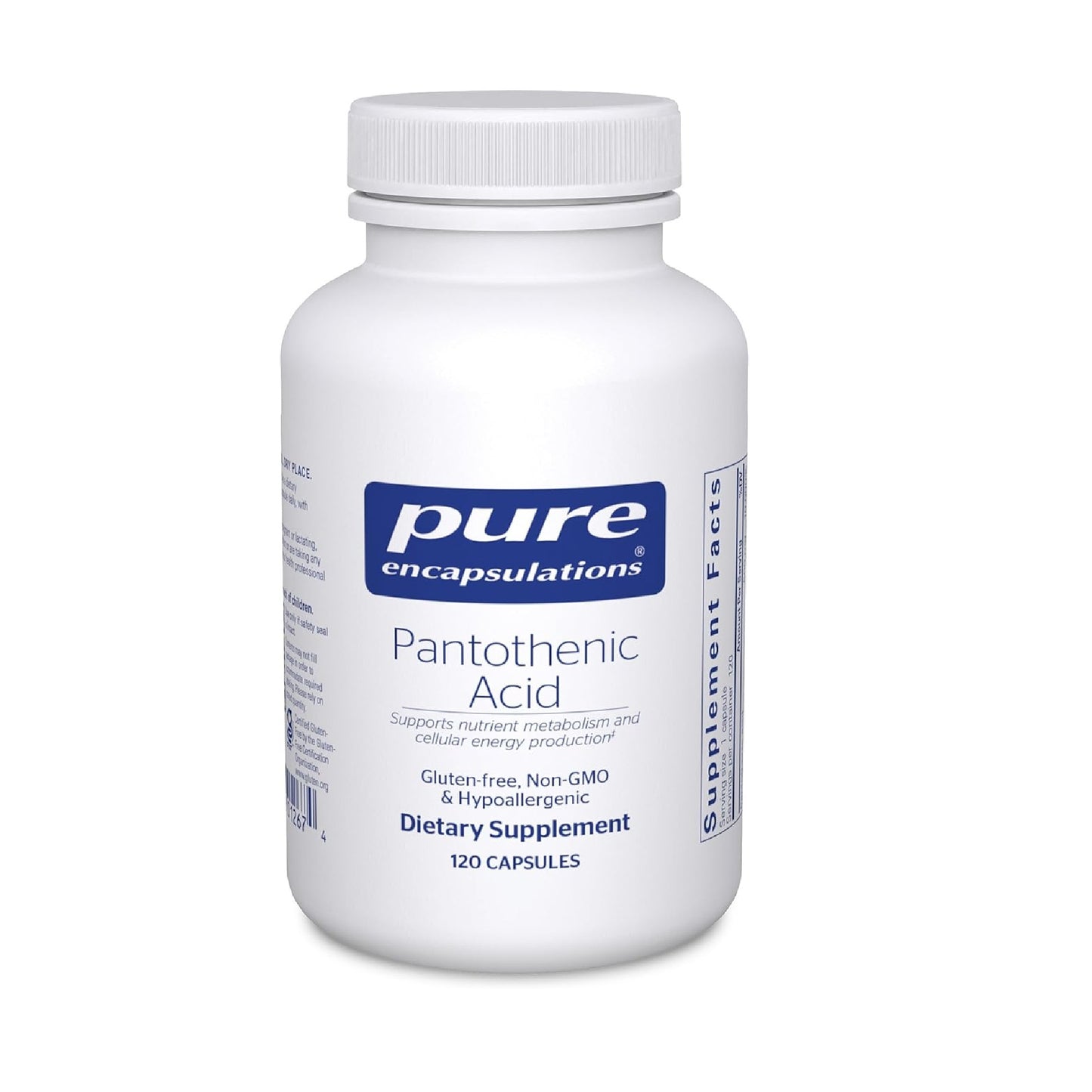Pantothenic Acid
Ready to ship - 6 left
Why Pantothenic Acid?
Pantothenic acid (B6) is a precursor of coenzyme A (CoA), an important cofactor and acyl group carrier in cells. One of the main functions for CoA is the formation of acetyl-CoA, vital for cellular respiration and the metabolism of carbohydrates and fatty acids through the Krebs cycle. Distribution studies indicate that tissues with the highest retention of pantothenic acid are the kidneys, pituitary gland, heart, muscle, liver and adrenal glands. Additionally, pantothenic acid is required for the synthesis of fatty acids and membrane phospholipids, the amino acids leucine, arginine and methionine, and isoprenoid derivatives, including steroid hormones, vitamin A and vitamin D. Pantothenic acid supports cellular energy production, adrenal and cardiovascular health, and synthesis of vitamins, amino acids, fatty acids, and steroid hormones. Additionally, pantothenic acid is required for the synthesis of fatty acids and membrane phospholipids, the amino acids leucine, arginine and methionine, and isoprenoid derivatives, including cholesterol, steroid hormones, vitamin A and vitamin D.
What Is The Source? Calcium pantothenate provides pantothenic acid and is synthetic. Ascorbyl palmitate is derived from corn dextrose fermentation and palm oil. Hypo-allergenic plant fiber is derived from pine cellulose.
Description
Why Pantothenic Acid?
Pantothenic acid (B6) is a precursor of coenzyme A (CoA), an important cofactor and acyl group carrier in cells. One of the main functions for CoA is the formation of acetyl-CoA, vital for cellular respiration and the metabolism of carbohydrates and fatty acids through the Krebs cycle. Distribution studies indicate that tissues with the highest retention of pantothenic acid are the kidneys, pituitary gland, heart, muscle, liver and adrenal glands. Additionally, pantothenic acid is required for the synthesis of fatty acids and membrane phospholipids, the amino acids leucine, arginine and methionine, and isoprenoid derivatives, including steroid hormones, vitamin A and vitamin D. Pantothenic acid supports cellular energy production, adrenal and cardiovascular health, and synthesis of vitamins, amino acids, fatty acids, and steroid hormones. Additionally, pantothenic acid is required for the synthesis of fatty acids and membrane phospholipids, the amino acids leucine, arginine and methionine, and isoprenoid derivatives, including cholesterol, steroid hormones, vitamin A and vitamin D.
What Is The Source? Calcium pantothenate provides pantothenic acid and is synthetic. Ascorbyl palmitate is derived from corn dextrose fermentation and palm oil. Hypo-allergenic plant fiber is derived from pine cellulose.
Pantothenic Acid
Ready to ship - 6 left
Why Pantothenic Acid?
Pantothenic acid (B6) is a precursor of coenzyme A (CoA), an important cofactor and acyl group carrier in cells. One of the main functions for CoA is the formation of acetyl-CoA, vital for cellular respiration and the metabolism of carbohydrates and fatty acids through the Krebs cycle. Distribution studies indicate that tissues with the highest retention of pantothenic acid are the kidneys, pituitary gland, heart, muscle, liver and adrenal glands. Additionally, pantothenic acid is required for the synthesis of fatty acids and membrane phospholipids, the amino acids leucine, arginine and methionine, and isoprenoid derivatives, including steroid hormones, vitamin A and vitamin D. Pantothenic acid supports cellular energy production, adrenal and cardiovascular health, and synthesis of vitamins, amino acids, fatty acids, and steroid hormones. Additionally, pantothenic acid is required for the synthesis of fatty acids and membrane phospholipids, the amino acids leucine, arginine and methionine, and isoprenoid derivatives, including cholesterol, steroid hormones, vitamin A and vitamin D.
What Is The Source? Calcium pantothenate provides pantothenic acid and is synthetic. Ascorbyl palmitate is derived from corn dextrose fermentation and palm oil. Hypo-allergenic plant fiber is derived from pine cellulose.
Description
Why Pantothenic Acid?
Pantothenic acid (B6) is a precursor of coenzyme A (CoA), an important cofactor and acyl group carrier in cells. One of the main functions for CoA is the formation of acetyl-CoA, vital for cellular respiration and the metabolism of carbohydrates and fatty acids through the Krebs cycle. Distribution studies indicate that tissues with the highest retention of pantothenic acid are the kidneys, pituitary gland, heart, muscle, liver and adrenal glands. Additionally, pantothenic acid is required for the synthesis of fatty acids and membrane phospholipids, the amino acids leucine, arginine and methionine, and isoprenoid derivatives, including steroid hormones, vitamin A and vitamin D. Pantothenic acid supports cellular energy production, adrenal and cardiovascular health, and synthesis of vitamins, amino acids, fatty acids, and steroid hormones. Additionally, pantothenic acid is required for the synthesis of fatty acids and membrane phospholipids, the amino acids leucine, arginine and methionine, and isoprenoid derivatives, including cholesterol, steroid hormones, vitamin A and vitamin D.
What Is The Source? Calcium pantothenate provides pantothenic acid and is synthetic. Ascorbyl palmitate is derived from corn dextrose fermentation and palm oil. Hypo-allergenic plant fiber is derived from pine cellulose.

Provisions Sells Provisions!
Along with the plethora of other brands we sell, we also have our own brand of select products! Come check us out!










